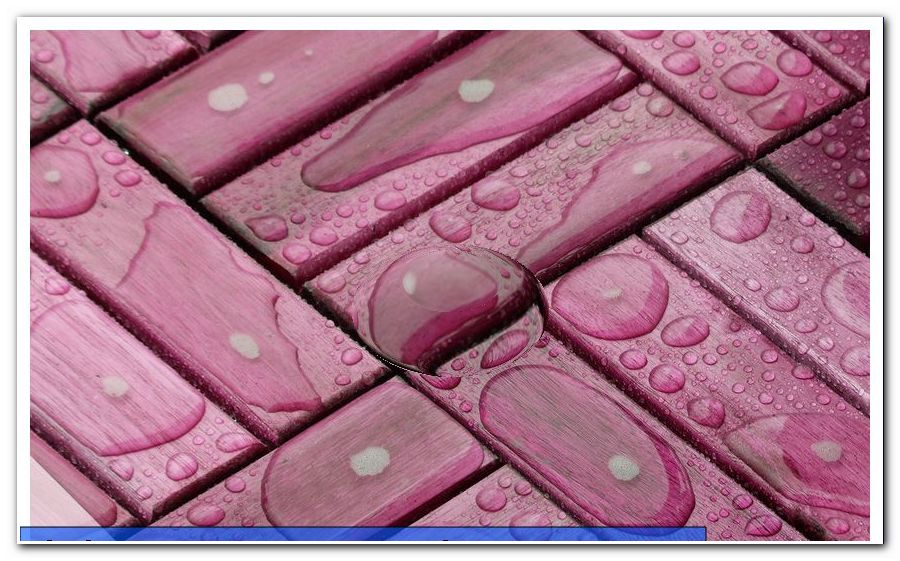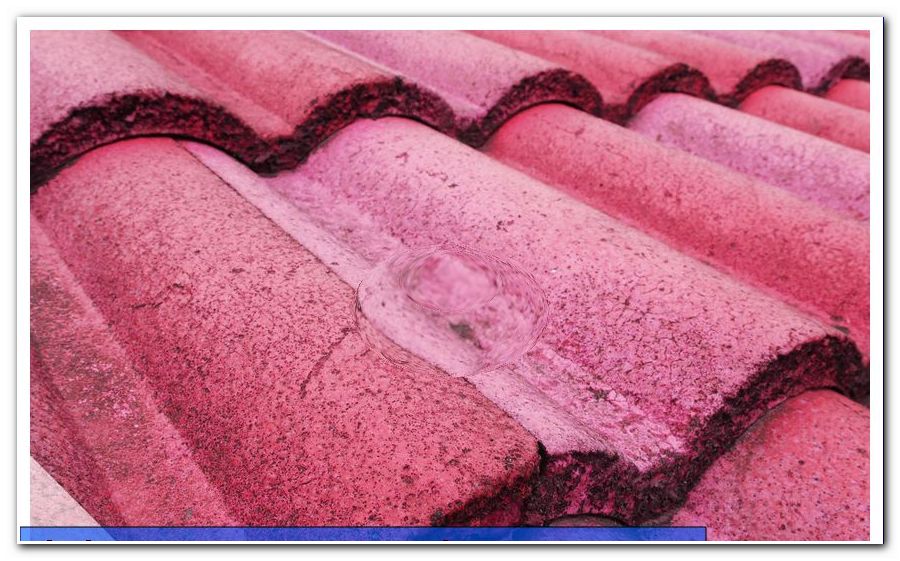Descale the kettle - these home remedies help

- 1. Descaling with vinegar essence
- 2. Decalcify with citric acid
- 3. Descale with baking soda
- 4. Descaling with vinegar cleaner possible "> 5. Descaling with soda
- 6. Other home remedies
Lime deposits in the kettle are caused by hard water. Water with a high of calcium and magnesium ions occurs in some areas. Even though utilities remove some of the water hardness during treatment, the remaining ions in some regions still make tap water harder than others. The water hardness is measured in ° dH (degree of German hardness). From about 14 ° dH water is considered very hard.
Formation of lime deposits
When the water is heated, the lime precipitates, forming water-insoluble, particularly hard compounds that are deposited on all surfaces inside. In order to dissolve these compounds, substances with special chemical properties are needed, such as the home remedies listed below.
Throwing away is not necessary
You could now easily consider the kettle as a disposable item, and simply throw it away at the signs of limescale. But that is not very ecologically thought, and absolutely unnecessary. Limescale deposits can be quite well removed by several means that are present in every household.
Is lime harmful in the water?
Granted: The deposits do not look very nice, but they are completely harmless to health. Rather on the contrary: Calcium and magnesium are very important substances in our body, which we often even lack. This is particularly evident in that in some areas with soft water, the number of certain heart diseases is usually higher than in areas with particularly hard water. And lime does not cause the "calcification" of the vessels and the brain - for completely different substances are responsible. The word calcification was used only as a comparison.
Only tea and coffee lose to too hard water to taste. For a much better taste experience a regular decalcification is worthwhile in any case.
1. Descaling with vinegar essence
Vinegar essence is highly concentrated vinegar. For this reason, when decalcifying with this remedy, you have to be a little more careful and dilute it. Vinegar is a strong acid, and also occurs in nature. Therefore, acetic acid is also completely biodegradable and harmless to the environment.

Procedure for descaling
1. Rinse the kettle thoroughly with cold water - Rinse away loose limescale and chunks from the kettle. Part of the deposits also dissolves from the heating rods. The subsequent release of the deposits is then easier and more effective.
2. Fill Essence Essence - Add a cup of vinegar essence to your device. That's enough for most sizes of kettles, as the heating area in which there are deposits is about the same size on most appliances.
3. Dilute vinegar essence - After the vinegar essence, add two cups of cold water to the kettle. This is necessary to dilute the vinegar essence to the correct size and to avoid damage to the plastic parts. Excessive acid concentration can also attack the metal parts.
4. Allow to soak in - Allow the diluted solution to work overnight. In the morning, you can drain the mixture with the dissolved lime then rinse thoroughly again. The vinegar smell then vanishes almost immediately.
2. Decalcify with citric acid
Citric acid is also a proven home remedy for descale. You will receive it in every supermarket in the back department in small bags, in addition, also in dissolved form in the small yellow or green plastic vials. For the removal of lime, the powdered form is better. It is a white, crystalline powder that has about the same consistency as sugar.
Caution: Citric acid may only be used for cold descaling. Never heat the water! This would create deposits of calcium citrate that are even worse and more persistent than limescale from the water!
application
1. Dissolve one packet in one and a half cups of water. You do not need to dilute liquid products so much. Use lukewarm (not hot!) Water. This dissolves the powder a little faster. Even an acid concentration of 8% ensures good efficacy. Do not overdo it with the concentration of the acid. Much helps much is not appropriate here.
2. Add 1 - 2 cups of this mixture to the unit as needed. All lime-encrusted parts inside should be well covered by the mixture.
3. Leave on - Let the mixture work for about 30 minutes. Then check the result.
4. Repeat - If the result was not satisfactory after the first try, just repeat it again. You can also add more of the mix to a large amount of debris and let it work for longer. It should not be more than 2 - 3 hours.
After exposure, always rinse thoroughly with water.
3. Descale with baking soda

Also, baking soda can be used to remove lime. It consists essentially of soda (sodium bicarbonate) and an acidifier. When it comes into contact with heat and moisture, carbon dioxide is liberated and the known foam bubbles form. The remaining part of the dissolved baking powder then forms an acid which can be used for descaling.
Note: For baking soda to form an effective acid, it needs moisture (water) and heat. It only works when the water is heated!
method
1. Empty baking soda into the machine - In most cases, you will end up with a bag. If in doubt, you can also use a second bag.
2. Fill up with water - Do not fill up with water up to the maximum mark. 2/3 of the maximum amount of water normally suffice. There should be some room left to absorb the carbon dioxide foam.
3. Switch on the appliance - Let the water boil. Be careful not to let the gas bubbles over the lid. In this case carefully pour off something, the foam has no limescale effect anyway. After boiling, let the mixture stand.
4. Exposure time - Allow the mixture to cool and let it work for about 1 to 1.5 hours. Then pour out and check the result. If it is unsatisfactory, repeat again if necessary, or resort to a stronger remedy (vinegar, citric acid).

4. Descaling with vinegar cleaner possible "> 5. Descaling with soda

Soda is a proven home remedy that is used for an incredible number of purposes. It can be used as an additive when blanching vegetables to preserve the color, for brushing, but also for heartburn. In ancient times, soda was the household remedy that has been used for practically everything.
From a chemical point of view, soda is a compound called sodium bicarbonate (NaHCO3). Because it has been used for centuries, many other names have come to be known for the white powder:
- Sodium bicarbonate
- baking soda
- bicarbonate of soda
- baking soda
- baking soda
- Bullrich Salt
- Emperor Natron
The ingredient is always the same: sodium bicarbonate.
Procedure for descaling
Similar to baking soda, you also need an acidifier when decalcifying with soda. For this you can use citric acid or vinegar.
The recipe:
- 3 teaspoons of soda
- 2 tsp citric acid (alternatively: 2 tbsp vinegar essence)
- 2 cups of water
The mixture should be allowed to work overnight. Pour then in the morning, and check the result. In any case, thoroughly rinse the kettle several times before use. Alternatively, you can of course - as described above - also use baking soda.
6. Other home remedies
These are the most proven home remedies that are also effective. There are also some other "exotic" remedies to help remove the debris.
For example, cola has a reputation for effectively removing all types of deposits (including urine scale and rust). This is because cola contains a small amount of phosphoric acid. This acid reacts with many deposits and dissolves them completely over time. However, since the of phosphoric acid in the cola is quite low, the exposure times are correspondingly long. Over a correspondingly long period of time, however, cola is quite reliable.
Softening water - that brings something "> 
No "physical water softening"
Devices for "physical water softening" are to make the lime in the water "harmless" by magnetic action. Stiftung Warentest has so far found in none of these devices a detectable effect, scientific evidence for the method is also not there. But these devices are often sold at the front door - and fancy prices required. You should therefore keep your fingers off it.
Tips for quick readers:
- Chemical descaling agents - often numerous chemical substances
- Effective home remedies: strong acids (acetic or citric acid) - always dilute
- Also baking soda can be used
- Natron needs an additional acid carrier (vinegar, citric acid), or use baking soda instead
- Do not use vinegar cleaner to descale
- NEVER heat citric acid solutions (this will cost you your kettle)
- Washing machine and dishwasher do not need softened water
- Devices for "physical water softening" (with magnets or current flow) have no detectable effect
- Hard water is not harmful at all, lime is a deficiency




